
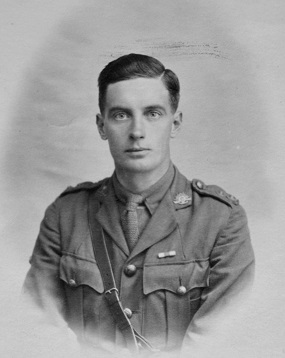
John Charles Robertson - World War 1 photograph.
John Charles Robertson (known as 'Jack' and 'Robbie') was born on 28 October 1894, the eldest child of George Archibald Robertson and Jessie Mary Ethel (nee Neilson).

Believed to be John Charles Robertson in 1897.
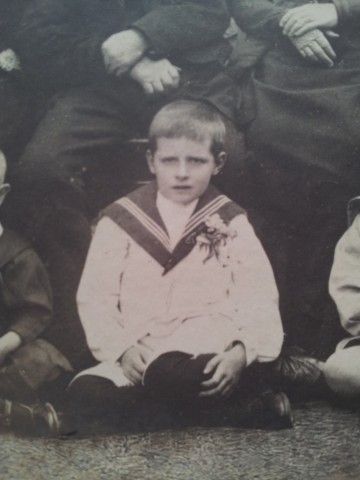
John Charles Robertson at a family gathering in 1902.
John received his primary and secondary education in Geelong. He was recorded as a student at the Geelong College in 1909 and may have attended for a longer period. He gained equal second prize in Geometry, second prize in Latin, and second prize in French that year. His valete (exit record) simply lists him as a member of form ‘Upper IV’. His address in 1909 was 17 Elizabeth Street, Geelong.
John's Army Record Book shows that he registered in the Senior Cadet Service, aged 16, on 31 January 1911 in Geelong. He had his first medical examination on 7 March 1911 at which his height was shown as 5' 4 & 3/4". He was 8 stone 1 lb in weight. His eyesight was normal and he had a vaccination scar on his left arm. His address was shown as 41 Aphrasia Street, Newtown, Geelong.
On 12 December 1911, John was promoted to the rank of Sergeant in training area 69B. Four months later, on 24 April 1912, John undertook a further examination for entry into the Citizen Forces. By this time he was 5' 6 & 1/4" tall and 9 stone 3 lb in weight. He was exempted from training for three months to 8 June 1912 due to an unstated illness.
After completing his secondary education at the end of 1912, John joined Hawkes Bros, Hardware and General Merchants in Geelong, a company that carried all lines including iron, steel, tools, brushware, and so on. Over three years he filled various positions in the office and warehouse including filling country orders. He left, aged around 20, to join his father in his late grandfather’s firm, now named John Robertson and Sons Pty Ltd. He worked in that firm for a further three years as an Invoice and Ledger Clerk. During this period John took a course in carpentry and joinery at the Gordon College of Technology as well as a two-year night course in bookkeeping and accountancy.
Sometime before 1912, John became romantically interested in a local Geelong girl, Margaret Dorothy Aikman. Family photographs featured the pair several times, including in a large group of friends at Eastern Beach in Geelong.
Margaret Dorothy (also known as ‘Dorie’ or ‘Dot’) was the eldest child of Alexander Aikman (senior) and Margaret Knight Clement. The Aikman family hailed from Stirling, in Scotland, while the Clements were English.
John was promoted to Sergeant on 12 February 1913, then to Color-Sergeant on 18 August 1913. John was formally appointed, on 16 May 1914, as ‘an Officer of the Military Forces of the Commonwealth’, to the rank of 2nd Lieutenant (Private). By September 1914, John had been issued with various equipment, including a rifle 3851, a bayonet and scabbard, a sword No 395, and a greatcoat. He was promoted to the rank of Lieutenant on 1 July 1915 with the words 'Passed for Captain' recorded (but undated) directly under the previous appointment.
John was certified to be 'medically fit for active service' when he enlisted as a Private with the Australian Imperial Force (AIF) on 23 July 1915, aged 20. It was later noted in local newspapers that he joined the AIF as a Private ‘as it was necessary at that time for holders of commissioned rank to be more than twenty-three years of age’. As an Acting Sergeant with the 23rd Battalion reinforcements, John embarked for Europe on 8 February 1916 on board the HMAT A68 Anchises. When he disembarked in Egypt in April 1916 the 23rd Battalion was already in France. Soon after his arrival in Egypt, John wrote one of his first letters to Dorie on the back of a postcard.
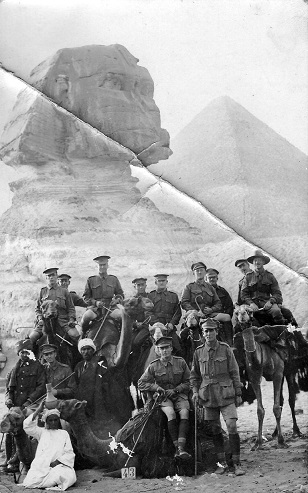
John (sitting on camel, front) in Egypt with Australian troops.
John Robertson arrived in France by May 1916, a month after the 23rd (6th Brigade, 2nd Division) had occupied forward trenches in the Armentieres sector in northern France. John's Statement of Service states that he had a mid-ear infection and was admitted to the 26th General Hospital from 24 May to 30 May, and then back again the same day until 6 June 1916. On 25 June 1916, John was appointed acting/Sgt 'EDP' at the 1st Anzac Entrenching Bn, France.

Map of the Battle of Pozieres. The town of Querreau, where John was photographed later (see below) can also be seen.
On 1 August 1916, John was marched out to 'join unit'; he was taken on strength with the 23rd Battalion on 4 August 1916. John fought with the 23rd Battalion at the Battle of Pozieres (23 July to 7 August 1916), (an important and heavily fortified German defensive position) from 4 August 1916 where he was wounded. As a result of his wounds he may not have participated in the Battle of Mouquet Farm (23 July to 3 September 1916) which the 23rd fought in from mid August. The 23rd is estimated to have lost almost 90% of its original members in these two battles; the 2nd Division alone had approximately 8,100 casualties.
John Robertson was promoted to 2nd Lieutenant on 14 August 1916. He was evacuated to hospital on 24 October 1916 with mild 'NYD' until 4 or 6 November 1916. From 3 November to 6 November, he was admitted to hospital with 'influenza of stomach', re-joining the 23rd Battalon on 6 November 1916. He received a promotion to Lieutenant on 4 January 1917.
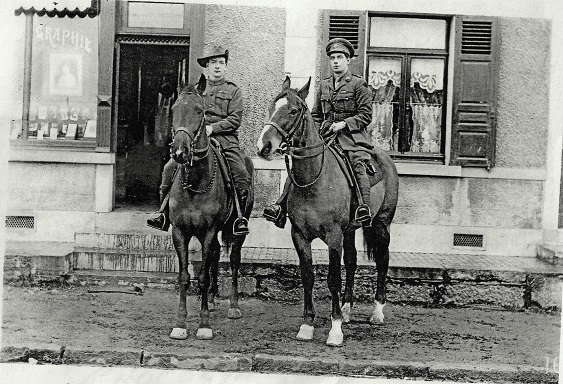
John (right) and his first cousin William Gray Dixon Robertson in an unstated location in France or Belgium. (Source - Warland/Robertson family collecton).
John transferred to the 6th Light Trench Mortar Battery on 6 April 1917. A few weeks later he fought at the second Battle of Bullecourt (also known as the Battle of Arras, 3 to 17 May 1917) where he constructed a mortar out of two broken ones he found in a German trench and used it to fire over 230 rounds. For this action, John was awarded the Military Cross, recorded in the Commonwealth of Australia Gazette No 189 of 8 November 1917. The citation reads:
For conspicuous gallatry and devotion to duty. He handled his section with great courage and determination under heavy fire and against enemy counter attacks. His work was of the greatest assistance to the infantry'.
It is not known where the 6th ALTM Bty was located from May to October 1917.
On 6 October 1917, John was wounded in action on 4 October and admitted to St Johns Hospital, Etaples, with a gun shot wound (GSW) to his arm; two days later he embarked for England to recover from the wound. His service history states that, as he was 'wounded (he was) placed on the seconded list and ceased to be seconded with the 6th ALTM Bty'. On 1 December 1917 he was admited to the Grove Military Hospital in Footing, UK.
John Robertson returned to France on 15 January 1918 and was initially assigned to the Australian General Base Depot. On 19 January 1918 he was re-assigned to the 6th Australian Light Trench Mortar Battery, which he re-joined on 24 January 1918. On 11 February 1918, his service file states that he was 'seconded for duty with the 6th ALTM Bty'. John was photographed with other members of the 6th Light Trench Mortar Battery at Querrieu, France, on 27 June 1918 and again in July 2018.

John (far left) was photographed with other members of the 6th Light Trench Mortar Battery at Querrieu, France, on 27 June 1918.
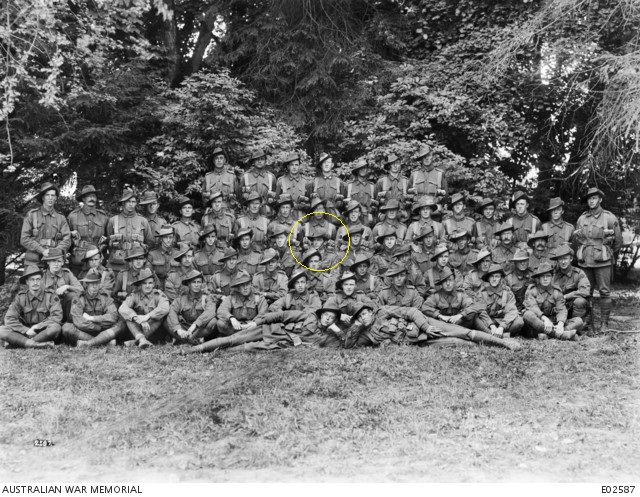
A group photograph of the 6th Light Trench Mortar Battery taken in July 1918. John, who is looking to the right, is circled. (Source: Australian War Memorial, which includes the list of all the men in the photo.)
On 3 July 1918, John Robertson ceased to be seconded to the 6th ALTM Bty and was seconded for duty with the Australian Corps School.
On 6 August 1918, John was accidentally wounded in the ankle following live practice when he picked up a Stokes (mortar) shell which ‘had the top guide nipple fractured which allowed the ignitions set to fall out, and on impact with the ground the ignition set exploded, causing injuries to Lieut Robertson's left leg'. John received three small but not significant wounds to his leg. John’s Statement of Service shows that he was admitted to hospital in Abbeville for almost two months from 7 August to 5 October 1918 as a result of the accidental gunshot; he also caught the flu in the last six days of that hospital stay.
After the war, John was assigned to ‘administrative work’ at Headquarters in London for five months prior to embarkation home. He was apparently given the opportunity to qualify for the Diploma of Forestry at Edinburgh University some time in 1919 but it is believed he did not take up that opportunity, although it is known from family letters that he spent some time in Edinburgh in that year. John arrived back in Australia on 4 January 1920 on the HMT Ypiringa.
Immediately on return he commenced again with Pettitt Robertson Pty Ltd (John Robertson and Sons Pty Ltd amalgamated with Pettitt in 1920) in charge of their Order Dept. He continued with the Militia Forces during the 1920s and maintained his connections with the military. Most years he went away to Army Camp and often also to a school.
John married Margaret Dorothy Aikman (26 Apr 1896, Geelong - 9 Apr 1964, Geelong) on 23 September 1922. Dorothy was the daughter of Alexander Aikman (16 Feb 1867, Geelong - 17 Jul 1943, Geelong) and Margaret Knight Clement (20 Jul 1875, Geelong - 29 Feb 1969, Geelong).

John and Dorothy's wedding photograph. His best man was his cousin, William (Billy) Gray Dixon Robertson.
After marriage they resided at 3 Claremont Avenue, Newtown in the house they had constructed while John was in charge of Pettitt Robertson’s Order Department.
John and Dorothy Robertson had the following children:
For about five years John was a buyer for Pettitt Robertson, travelling in Tasmania, NSW and all over Victoria inspecting and procuring their requirements for contracts with the Melbourne Harbour Trust, Tramways Board, Electricity Commission etc. In the late 1920's he was in charge of the Geelong yard and dispatch where one of his duties was to inspect and report on all timbers received.
Exactly when John ceased to work for Pettitt Robertson has yet to be confirmed. His father George retired from the business in late 1929. The family recall that John also ceased working for the business in 1929 'because of the depression' but it may have been a year or so later, when the business was starting to struggle. His eldest son Jock was a student at Newtown Primary School but the family were forced to sell their property and move to Belmont from where Jock was sent to Chilwell Primary School. Times were very hard.
According to family history, John heaved bails of wool in the Wool Stores, drove an ice truck, and finally commenced selling wood (for fuel) from a house with a vacant block in Chilwell owned by his father-in-law. (This property was bequeathed to Margaret Dorothy on her father’s death.)
In 1932 John was top of his 21A Course under Major Pain of 4th Division. In 1933 he was O.C.A. Coy, in the 23rd Battalion (his war time battalion and the City of Geelong Regiment). He was awarded the V. D. (Victoria Decoration) during this period.
In November 1933 he applied for the position of Manager of Reg Williams Timber Yard in Hamilton (at 375 pounds per annum). In his applications he said 'At present, I have a fuel business which though successful in a small way I regard as a temporary expedient.'

John's handwritten draft application.
Fortunately, the fuel business prospered and John added petrol bowsers to the business, located on the corner of Sharp and Pakington Streets. He bought another block on the other side of the house to carry more stock.

John's fuel store on the corner of Sharp and Pakington Streets.
The business prospered enough to send his children to public schools and to comfortably maintain his family. He also built a small cottage at Ocean Grove.
On 3 April 1935 John was promoted Major. When war was declared on Germany on 3 September 1939, John was second in command of the composite 23rd/21st Battalion. Lieutenant-Colonel Arthur Harry Langham Godfrey, the Battalion’s Commanding Officer since October 1939, was seconded to the A.I.F. on 13 October 1939 and given command of the 2/6th Battalion which embarked for the Middle East in April 1940.
John formally enlisted in the 2nd A.I.F. on 29 October 1940.
On 7 November 1940, the Geelong Advertiser noted that the Minister for War (Mr Spender) had announced John’s promotion to Lieutenant-Colonel and command of the 2/29th Battalion.
John was told to build up his battalion as quickly as possible and, to do that, he interviewed officers of the 2/21st and 2/22nd Battalions between 4 and 6 November, and went to Tasmania to interview officers of the 2/40th on 8 November 1940. On 13 November, Major J K Lloyd was appointed 2IC of the Battalion. On the same day, John went to Sydney to 8 Division HQ and were briefed on future training. On 16 November they went to see the site at Bonegilla Camp to be occupied by the unit where it was to be concentrated.

Screen capture of John at Segamat Camp, Malaya, 1941.
Details of John's command of the 2/29th Battalion until his death are contained in the book 'Robbie to Dorie', released on 24 April 2014.

John with Brigadier Maxwell and the other Lt Cols of the 27th Division.
John Charles Robertson died from gunshot wounds (from Japanese soldiers) and a possible head injury when he fell off the back of a motor cycle returning from Division HQ near Bakri village, Malaya, sometime before 11 AM on Sunday 18 January 1942. For details of the battle, see this page.
John's death was reported in the Geelong Advertiser on 21 January 1942. The article noted that '... while no details have been announced, it is believed that Lieutenant-Colonel Robertson was leading a battalion against the Japanese in the Muar River section, where the Australians threw back a heavy tank attack after Indian troops had been forced to give ground.'
In a letter dated 2 June 1949, the Department of the Army wrote to John's wife Mrs M D Robertson, of 348 Pakington Street, Geelong, 'to advise you that information has been received that the remains of your late husband, VX38975, Lt-Col J C Robertson, 2/29 Aust Inf Bn, have been received and buried in the Singapore War Cemetery, in Collective Grave 'O', Plot 20, Row A, Grave 12.' The letter also noted that 'it is advised that a collective grave is established in cases where a number of remains are known to be those of certain deceased members but individual identification is not possible'.
According to his son Jock, John Charles Robertson was an enigmatic man - straight, trustworthy, kind, but with the quiet confident personality that gave him his leadership qualities. Although in later life a member of the Board of St. David’s, Newtown, he was not a man of the Church and did not often insist that his family attend.
According to his obituary in the Geelong Advertiser dated 19 January 1942, John '... devoted a good deal of his spare time to the work of various bodies of which he was a member, including Geelong Legacy Club, the board of management of St David's Presbyterian Church, the committees of Chilwell State School and Chilwell Free Library, and the Geelong Branch of the 23rd Battalion (AIF) Association of which he was the first president. He was treasurer of the Alba Social Club which, as a result of its activities, distributed some hundreds of pounds among Geelong charities'.
For information about each of the children (all of whom passed away in 2011), click on the relevant link:
Alexander John (Jock)Robertson (1923 - 2011)
William Cargill (Cargill, Carg) Robertson (1925 - 2011)
Margaret Pamela (Pam) Robertson (1928 - 2011)
Page created 11 December 2011, updated 19 January 2024 (minor fix). Copyright © Andrew Warland. (andrewwarland(at)gmail.com)